Ducks and A Lot More
A multitude of wildlife species benefit from DU's work in addition to waterfowl
A multitude of wildlife species benefit from DU's work in addition to waterfowl
By T. Edward Nickens
It's easy to understand that taking care of ducks helps a lot of other wildlife species. Obvious creatures come to mind: marsh hawks and wading birds, river otters and shorebirds. But what about moose and musk ox? Northern pike and brook trout? Even rare dragonflies, everyday bumblebees, and migrating songbirds? DU's work across North America is unquestionably focused on webbed feet and flight feathers, but the cascade of positive effects from hard work on wetlands conservation is a huge boost to other wildlife.
"Waterfowl conservation catalyzes our action," explains Jerry Holden, director of operations in DU's Southern Region. "But the underpinning of DU's mission is to restore ecosystems. Ducks and geese are primary in our hearts and heads, but we can't have them without healthy ecosystems."
And healthy ecosystems support all those other wildlife species that enrich our days afield.
Here are five North American habitat types where DU works hard for waterfowland where an incredible array of other wildlife live, raise young, and spring forth in every marsh, creek, coastline, and backyard.

Photo JEANNETTE TAS, NETHERLANDS
Early one morning I slipped a canoe into a blackwater creek that runs deep into eastern North Carolina's Roanoke River National Wildlife Refuge. In the winter, I'd be after the refuge's astonishing variety of waterfowl: pintails, wigeon, mallards, black ducks, wood ducks, gadwalls, and ringnecks. But this morning, as my paddle sliced into tea-colored water, 16 species of singing birds called within a two-minute span, each one on a list of 30 birds of conservation concern, and each one reliant on seasonally flooded bottomland hardwood forests.
I heard yellow-throated warblers14 percent of the world's population of this speciesbreeds in North Carolina's bottomland forests. Prothonotary warblers flitted against the dark cypress and tupelo gum trees like gold sparks. One in five of all prothonotary warblers in the world rely on bottomland forests in eastern North Carolina. As do 11 percent of all Acadian flycatchers.
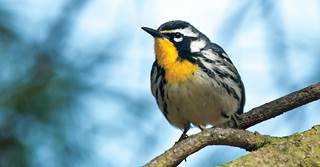
Photo PAUL REEVES PHOTOGRAPHY
And what I didn't see might be just as impressive. On my paddle through the wet woods, I likely passed, hidden in the cathedral of trees, roosting colonies of Rafinesque's big-eared bats and southeastern myotis, forest-dwelling bats that form large maternity colonies inside the hollow trunks of huge gum and cypress trees. The spring floods had overtopped the river's banks, giving migrating striped bass and resident redbreast sunfish access to nutrient-rich feeding grounds.
There's an entire suite of birds and wildlife that has evolved to thrive with periodic flooding in these bottomland forests, which we've altered with flood control and outright habitat destruction. Keeping those populations healthy requires both habitat protection and restoration.
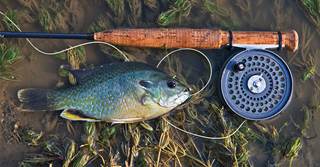
Photo TODDSTEELEPHOTOART.COM
And the challenge is daunting. Along the Mississippi River, most of the region's alluvial forests are gone. "Of the 25 million historic acres," says Holden, "only 6 to 7 million acres are left, and much of what remains is impaired." Levees have protected downstream human communities and cropland, but the altered hydrology has moved water into the woods for longer and longer periods of time. "Flooding is required in these habitats," Holden says. "But now so much water remains for so long, it's really hampering the ecology of these natural systems."
DU's work to hang on to these habitats includes extensive public-private partnerships such as the current effort to restore Arkansas's famed greentree hunting areas and the reforestation of bottomland hardwoods on marginal, flood-prone agricultural lands. Since the 1990s, the Wetlands Reserve Program, administered by the USDA Natural Resources Conservation Service (NRCS), has enabled DU and other partners to restore and protect more than 1 million acres of bottomland hardwood forest in the Mississippi Alluvial Valley. "And we're continuing that progress," Holden reports. "Those kinds of wins aren't true of a lot of other ecosystems. We've stopped the bleeding, and now we're slowly going in the right direction."
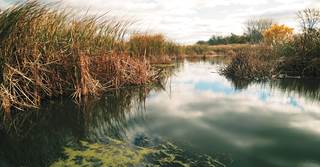
Photo JOSEPH PIQUET / ALAMY STOCK PH
With 60 million acres of water surface holding 20 percent of the planet's freshwater, it's easy to think of the Great Lakes as a vast, interconnected inland oceanan open-water world of whitecaps; deep, cold canyons; and giant wind-driven tides called "seiches" that roll over shorelines with the suddenness of a tsunami.
But that's not how a northern pike sees the Great Lakes. Or a king rail or even a Hine's emerald dragonfly. For many wildlife species, the Great Lakes are all about the edges. Here, more than 11,000 miles of coastline support some of the richest wetland complexes in North Americamarshes, fens, bogs, freshwater estuaries, dune-and-swale mosaics, and lake-plain prairie. Water levels rise and fall to build rich, interwoven habitats. It's home sweet home and a much-needed migratory stopover for huge numbers of diving ducks and dabblers that follow the Atlantic and Mississippi Flyways, as well as for upland game species such as rails and Wilson's snipe. But for northern pike, yellow perch, and famed "coaster" brook trout, the future hinges as much on shoreline wetlands as on classic big-water habitats.
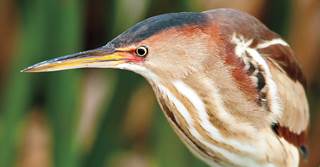
Photo BILL GOZANSKY / ALAMY STOCK PH
"These coastal marsh systems exist all along huge embayments in the Great Lakes," explains Dr. John Coluccy, director of conservation planning in DU's Great Lakes/Atlantic Region. "They cover square mile after square mile along Green Bay, Saginaw Bay, Lake Saint Clair, and the Detroit River. There are very important historic coastal marshes throughout the region, and there has been an incredible amount of effort to restore them for both wildlife and fisheries."
Yellow perch, for example, spawn in both coastal wetlands and deep-water habitats, and for long-term population health, they need both habitat types. Muskellunge spend their early years as larvae tucked into the protective cover of sedges and bulrushes. "Providing wetland habitat with cover so those fish can get to a size where they're not lunch for every critter out there is an important piece of the puzzle that supports healthy fisheries," Coluccy explains.
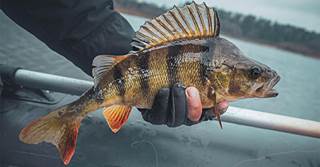
Photo WWWARJAG / ALAMY STOCK PHOTO
And then those fish have to find their way from wetlands back to open waters, which means navigating a labyrinth of man-made dikes, culverts, roads, and ditches. That's where DU's expertise and technical know-how come into play, leveraging dollars from sources such as the North American Wetlands Conservation Act and Great Lakes Restoration Initiative and delivering on-the-ground wetland restoration projects. In Michigan's Arcadia Creek/Bowens Marsh restoration project area, for example, ditches had blocked fish passage, and channelized stream sections and poorly designed culverts had warmed the waters and stymied the movements of coho salmon and rainbow, brown, and brook trout. After restoring creeks to their original meandering courses and adding woody debris to provide foraging and protective cover, colder, oxygenated water began to flood through the marsh. Northern pike returned in droves. Populations of salmon and trout skyrocketed. Wild rice is coming back, as are least bitterns, which are a threatened species in Michigan and other states, and sandhill cranes.
"It's really an era of seeing multiple benefits from a single restoration project," Coluccy says, "and that's a very exciting development."
Whether you're clad in fins or feathers.

Photo MICHAELFURTMAN.COM
Baird's sparrows like things the way they used to be. They avoid grasslands with too much ground litter, brush, or burned detritus on the ground. They can get by in Conservation Reserve Program (CRP) plots and other plantings for wildlife, but they thrive in sprawling tracts of mixed-grass native prairie that have never seen a plow.
The challenge, explains Dr. Johann Walker, director of operations in DU's Great Plains Region, is that unbroken prairie "is a 10,000-year-old ecosystem. It's a diverse community of dozens of species of plants that intersect in complex webs and relationships." Once native prairie is plowed, the land can be replanted and restored. "But those biotic relationships are drastically and forever altered," Walker says. "Many species never recover to their former level, at least in the time scales which we have measured." And a Baird's sparrow knows the difference.
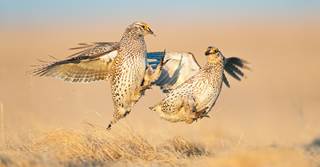
Photo DAVIDSTIMAC.COM
In that regard, they are not alone. Across the Prairie Pothole Region of the United States and Canada, collective populations of grassland birds such as Baird's sparrows, chestnut-collared longspurs, bobolinks, and northern harriers have fallen by more than half in the last 50 years. Thankfully, the habitats these birds depend on can be protected using one of the most powerful conservation tools ever devised: the conservation easement.
In many places, DU's work involves intensive restoration and engineering projects. But in the grasslands, it's a different approach. On the northern Great Plains, about 90 percent of the land base is privately owned, much of that by cattle operators who have embraced the compatibility of sustainable grazing and conservation planning. That's where Baird's sparrows thrive, as do breeding pintails and other ducks, western meadowlarks, and even monarch butterflies, whose larvae rely solely on milkweed pods, which are 60 times more numerous in grasslands than in croplands.
And even grassland birds that aren't solely dependent on native prairie benefit from the conservation of old-growth grasslands. Sharp-tailed grouse and prairie chickens can thrive in conservation plantings such as CRP, but their most robust populations are found in vast unbroken tracts of native prairie. Those grasslands and their ancient ecological webs now serve as reservoirs of native wildlife that can be tapped to repopulate adjacent lands restored by DU, the NRCS, and other partners.
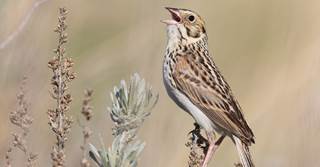
Photo DONALDMJONES.COM
"Look at how many millions of dollars have been and continue to be spent restoring lesser prairie chickens and black-footed ferrets where there are very limited viable wild populations to draw from," Walker explains. The bill for restoring grasslands runs about 10 times the cost of a perpetual conservation easement. Keeping native grasslands intact is not only the most biologically effective way of shoring up wildlife populations such as Baird's sparrows, but also the most cost-effective.
"Our remaining native prairie grasslands are so important for waterfowl," Walker says, "that it's almost like the grassland birds and pollinators and migrating sandhill cranes just come along for the ride. Thankfully, we have the tools and the willing partners to be clever enough to figure out how to hang on to all the habitat and wildlife we have left."
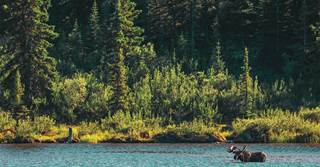
Photo LATENDRESSE MEDIA
Each night during the fall migration, under the cover of darkness, an average of 30 to 40 million birds fly south across the USCanada border. The flights continue, week after week, until as many as 5 billion birdsincluding 30 percent of North America's breeding waterfowl and their recently fledged offspringhave flooded south from the 1.3-billion-acre emerald halo that comprises the vast Canadian Boreal Forest.
"It's a challenge to wrap your head around a place so large," says Dr. Scott Stephens, DU Canada's director of conservation in the Boreal and prairie regions. "It's not just a big blob of green. Probably half of the area consists of fens and bogs and open-water marsh and swamp, all intertwined within this vast forest."

Photo DONALDMJONES.COM
That refuge pumps out more than mind-boggling numbers of birds. It's also home to some of the most iconic wildlife remaining on the planet, including at least 85 species of mammals. Grizzly bears, wolves, and wolverines thrive in these dark woods, along with moose and marten. On the forest floor, vast stands of lichens blanket peaty soils, providing crucial winter fodder for the region's woodland caribou. And in scattered bands, gigantic wood bisonmature males top 2,250 poundsreign as North America's largest land animal.
Thankfully, there is great cause for excitement in the realm of Boreal conservation, much of it rooted in new paradigms for conservation and fresh ways for Ducks Unlimited to partner with First Nations. "Indigenous peoples have known these lands for thousands of years," Stephens says, "and they are now driving the conservation decisions across the Boreal." The nexus of traditional knowledge with DU's cutting-edge mapping and technological capacity is creating entirely new ways of conserving large landscapes. First Nations bring to the table deep understanding about areas where they hunt and fish, trap, forage, and collect berries. DU scientists and staff overlay those values with habitat mapping and GIS technology, and help with on-the-ground stewardship training. The result is a deeply considered, culturally sophisticated way of conserving some of the most crucial wildlife habitat in North America.
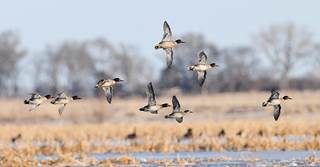
Photo JIM THOMPSON
And the fact that the region supports both charismatic resident wildlife and a trove of migratory birds that head south each fall only underscores the cross-border connections. "These indigenous communities hunt and fish, and they are committed to handing down those traditions to new generations," Stephens says. "Those are the same values held by many DU members across this continent."

Photo 2009 JEFF GOULDEN
Clasped between the snow-capped Cascade Mountains and the cliff-armored Washington shore, Puget Sound, the second-largest estuary in the United States, exists in a state of perpetual change. Pacific tides sweep in from the west. Freshwater flows pour in from some 2,800 creeks, streams, and major rivers. In this diverse region, you'll find a prolific mosaic of open water, freshwater marsh, and saltwater wetlands.
Salmon and steelhead need it all. Born in freshwater streams, juvenile fish drift and swim downstream to Puget Sound's brackish waters. Lined with pickleweed and seashore saltgrass, these habitats provide the just-right chemistry and safe haven required for the physiological transition to life in the sea. And it's not just these iconic fish that thrive here. Estuarine saltmarshes are some of the most productive ecosystems on the planet. Pacific herring spawn and Pacific brant feed in rich eelgrass beds. In these coastal marshes alone, more than 1,000 species of animals have been documented, from Dungeness crabs to sea lions. Just offshore, in Puget Sound's open waters, it's possible to pull off a sea duck quinfecta: black, white-winged, and surf scoters, plus long-tailed ducks and harlequin ducks.
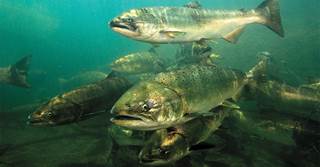
Photo MARK CONLIN / ALAMY STOCK
The fact that so much wildlife remains is a testament to decades of conservation work. Some three-quarters of historic tidal marshes in Puget Sound have been lost, and many of the estuary's saltwater wetlands have been diked and converted to other uses. DU's work involves restoring tidal flows to diked marshes using techniques that replicate natural hydrological cycles.
Conservationists must balance not only the needs of wildlife populations, but the desires of human communities that cherish varying facets of Puget Sound's richness. It's hardly straightforward, because the interrelationships within such biological diversity can be exceedingly complex. Along the coasts of British Columbia, Washington, and Oregon, for example, a threatened population of southern resident killer whales feed on salmon. Those are the same fish that stage in the Puget Sound saltmarshes as they acclimate to high salinityand the same fish so highly sought by both recreational and commercial anglers.
"Striking a balance from a wetlands conservation standpoint is a huge challenge," says Jeff McCreary, director of operations in DU's Western Region. "Saltmarshes support a food web from crabs to salmon to birds to people. While we have a focus on waterfowl habitat, we recognize that some recreational opportunities are unique to estuarine habitats and some to freshwater habitats. We must find a balance between the two."
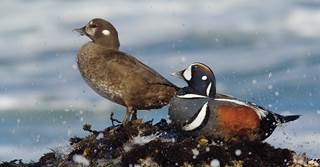
Photo KEN ARCHER
The best approach, says McCreary, is to look at the whole of Puget Sound as a system that is of vital importance to human, fish, and wildlife populations alike. "You can't put one too far above the others," he says, "because they depend on each other." And just as the Pacific Northwest's incredible bounty of water requires a fertile equilibrium, so, too, does the future of its wildlife.
Ducks Unlimited uses cookies to enhance your browsing experience, optimize site functionality, analyze traffic, and deliver personalized advertising through third parties. By continuing to use this site, you agree to our use of cookies. View Privacy Policy